My First Custom Bicycle: an Anniversary Retrospective
It's been about 13 months since I started riding my Royal H. mixte, so I thought it about time for a one year retrospective review. Together with my initial review and the earlier posts on the topic, this completes the story of my first experience with ordering a custom frame.
To summarise without repeating myself too much: This lugged steel mixte was built for me by Bryan Hollingsworth of Royal H. Cycles in 2009-2010. I described how I wanted the bicycle to look and feel, and he came up with the geometry and chose the lugwork and tubing. When the frame was done, the Co-Habitant and I built it up with components that we selected. For my initial review of the bicycle, please see here. A year later, my overall impression of it has remained largely unchanged. While in some respects I've become more critical of the bike after a year of use, I've also come to appreciate aspects of it that I had not even noticed initially. I will try to provide details on both counts.
Use History
Given that I ordered the mixte when my bicycle obsession was only starting to blossom and I knew next to nothing about frame geometry, this could have been a disaster. For example: While initially I wanted the bike for "touring" - which in September of 2009 I imagined myself doing in a skirt and on a semi-upright bicycle - by the time the summer of 2010 rolled around I had begun cycling with dropbars and my concept of "touring" had changed. Luckily, another thing that happened around this time, was that we gave up our car and suddenly I had the need for a long distance transportation bike. Unlike touring, I prefer an upright posture for transportation and I have to be able to ride in work-clothes, which usually involve a skirt. Thus, the mixte became a transportation bike - for which it turned out to be well suited.
I rode the bike throughout Autumn 2010, then hung it up toward the end of December and mostly rode my IGH (internally geared hub) bikes over the winter months.
In April 2011 the mixte was retrieved again, and has been in regular use since. It is my go-to bike for transportation-oriented trips of over 10 miles, and increasingly I found myself using it for shorter trips around town as well. I never had a computer on this bike, so I cannot tell you how many miles are actually on it.
Typically I will ride the mixte with a pannier, and recently I have also attached a small front basket in which I will carry additional items. The mixte handles fine with a light load in the front (i.e. whatever will fit in the basket) and a medium load in the rear.
Ride Quality
When I first began riding this bicycle, I spoke a great deal about its unusual ride quality, which at the time seemed mysterious to me. While my impressions have remained unchanged, I now understand a little better what is causing them. Basically, the frame and fork are quite flexible - more so than any bike I had ridden before or since. I can feel the bicycle "give" when going over a bump and I can feel it rhythmically "move with me" when I pedal hard in a high gear. This, in combination with the 35mm tires, makes it very cushy over pothole-ridden roads and also reduces fatigue on long rides. At the same time, the frame has what I would describe as compact, aggressive roadbike geometry: steepish angles, shortish chainstays, short wheelbase, mid-high trail. This makes it an impressively maneuverable, precise and quick-responding bike. The combination of that and the flex is unusual, and not everyone's cup of tea. However, I like it - and the more I own the bike the more I've come to appreciate it. The maneuverability and responsiveness have proven useful in traffic situations, especially as my bike handling skills improve and I am increasingly able to take advantage of its roadish features. The flex is a great relief over city potholes and long-distance rides: I never feel tired or "beat up." The bike accelerates quickly and likes to be in a high gear when going long distance. It is also a very light, effortless climber and going uphill is no trouble at all. So essentially what I have here is a roadbike with upright handlebars and a mixte frame, made comfortable via a greater than usual degree of flex.
Likes and Dislikes
Most of all, I like the ride quality, the compactness, and the light weight (< 25lb) of this bicycle. It is not only a fun and comfortable ride, but easy to take in and out of the house and, when necessary, to carry. I like the bike's versatility: I can take it grocery shopping or I can ride it to a meeting 10 hilly miles away, and gun it if I am running late. I like the set-up Bryan used for routing the dynamo lighting: a couple of subtle braze-ons on the inside of the fork blade and voila: It's neat and invisible. I like the stainless steel kickstand touch-points in leu of a welded plate. In general, the builder did a great job with the placement of the braze-ons for racks, front derailleur and other things: Everything is in the right place; everything is clean and precise. I like the quality of the paintjob, done by Circle A: Not a single chip after a year of use, which has included droppng the bike into thorn bushes. As far as the build, I am happy with most of it - in particular the fenders, racks and LED dynamo lighting that make this a fully equipped bicycle, while also keeping it lightweight.
As far as dislikes, I really have only one: toe overlap, which this bike has a bit of. I don't think I mentioned it in my initial review, because I didn't notice it until I began using the bike frequently for transportation. I go through stages where I think that maybe it's okay or not even there, but then occasionally I experience it and it bothers me. We switched the cranks from 170mm to 165mm and that helped, but not entirely. We talked of the possibilities of a 650B conversion or a fork re-rake, but upon more careful examination that won't work. To eradicate the toe overlap entirely, I would need a new fork - which would then need to be painted to match the frame and the whole thing would be a hassle. Not sure what to do yet; maybe a winter project.
There are other things that at some point I questioned, but have since decided are good. For example, while my initial impression was that the chainstays were too short (to carry standard sized panniers without heel strike), I have since found a number of panniers that work (see: Philosophy, Po Campo, Cristobal), so this no longer bothers me. The short chainstays contribute to the bike's compactness and spirited handling, so as long as they allow me to carry stuff I am happy.
Another thing - and this has nothing to do with the frame - is that I am rethinking the handlebar setup, just because I feel like a change. Not sure what I'll do yet, but in Spring 2012 you might see something different in place of the Porteur bars and inverse levers.
If I were doing this all over...
If I were ordering this mixte now instead of two years ago (wow has it really been two years?..), I would want to design it from scratch: specify the geometry, pick out the tubing, choose the lugset - basically what I did for the Randonneuring bike, only for myself. I would go one of two routes: Either keep the geometry exactly as it is on my current mixte, except ask for a longer virtual top tube, or I would make it a 650B low-trail bike, based on a pre-1950s porteur mixte design (I have a specific bicycle in mind whose measurements I want to replicate). Of course ideally, I would ask Bryan to make one of each and then test and compare them here - but for that I would need a lavish "Lovely Bicycle scientific studies" budget!
My motivation behind ordering a custom frame was atypical, in that it wasn't just for the sake of having a bicycle. From the very beginning I looked upon it as a learning experience in bicycle design. I wanted to understand how these things were done. Talking to Bryan about his process and being allowed to watch him work gave me my first inside look into the world of framebuilding. Two years later, my interest in it is only growing stronger. I am excited about bicycle design and looking forward to trying out more ideas. Thank you for following along!
To summarise without repeating myself too much: This lugged steel mixte was built for me by Bryan Hollingsworth of Royal H. Cycles in 2009-2010. I described how I wanted the bicycle to look and feel, and he came up with the geometry and chose the lugwork and tubing. When the frame was done, the Co-Habitant and I built it up with components that we selected. For my initial review of the bicycle, please see here. A year later, my overall impression of it has remained largely unchanged. While in some respects I've become more critical of the bike after a year of use, I've also come to appreciate aspects of it that I had not even noticed initially. I will try to provide details on both counts.
Use History
Given that I ordered the mixte when my bicycle obsession was only starting to blossom and I knew next to nothing about frame geometry, this could have been a disaster. For example: While initially I wanted the bike for "touring" - which in September of 2009 I imagined myself doing in a skirt and on a semi-upright bicycle - by the time the summer of 2010 rolled around I had begun cycling with dropbars and my concept of "touring" had changed. Luckily, another thing that happened around this time, was that we gave up our car and suddenly I had the need for a long distance transportation bike. Unlike touring, I prefer an upright posture for transportation and I have to be able to ride in work-clothes, which usually involve a skirt. Thus, the mixte became a transportation bike - for which it turned out to be well suited.
I rode the bike throughout Autumn 2010, then hung it up toward the end of December and mostly rode my IGH (internally geared hub) bikes over the winter months.
In April 2011 the mixte was retrieved again, and has been in regular use since. It is my go-to bike for transportation-oriented trips of over 10 miles, and increasingly I found myself using it for shorter trips around town as well. I never had a computer on this bike, so I cannot tell you how many miles are actually on it.
Typically I will ride the mixte with a pannier, and recently I have also attached a small front basket in which I will carry additional items. The mixte handles fine with a light load in the front (i.e. whatever will fit in the basket) and a medium load in the rear.
Ride Quality
When I first began riding this bicycle, I spoke a great deal about its unusual ride quality, which at the time seemed mysterious to me. While my impressions have remained unchanged, I now understand a little better what is causing them. Basically, the frame and fork are quite flexible - more so than any bike I had ridden before or since. I can feel the bicycle "give" when going over a bump and I can feel it rhythmically "move with me" when I pedal hard in a high gear. This, in combination with the 35mm tires, makes it very cushy over pothole-ridden roads and also reduces fatigue on long rides. At the same time, the frame has what I would describe as compact, aggressive roadbike geometry: steepish angles, shortish chainstays, short wheelbase, mid-high trail. This makes it an impressively maneuverable, precise and quick-responding bike. The combination of that and the flex is unusual, and not everyone's cup of tea. However, I like it - and the more I own the bike the more I've come to appreciate it. The maneuverability and responsiveness have proven useful in traffic situations, especially as my bike handling skills improve and I am increasingly able to take advantage of its roadish features. The flex is a great relief over city potholes and long-distance rides: I never feel tired or "beat up." The bike accelerates quickly and likes to be in a high gear when going long distance. It is also a very light, effortless climber and going uphill is no trouble at all. So essentially what I have here is a roadbike with upright handlebars and a mixte frame, made comfortable via a greater than usual degree of flex.
Likes and Dislikes
Most of all, I like the ride quality, the compactness, and the light weight (< 25lb) of this bicycle. It is not only a fun and comfortable ride, but easy to take in and out of the house and, when necessary, to carry. I like the bike's versatility: I can take it grocery shopping or I can ride it to a meeting 10 hilly miles away, and gun it if I am running late. I like the set-up Bryan used for routing the dynamo lighting: a couple of subtle braze-ons on the inside of the fork blade and voila: It's neat and invisible. I like the stainless steel kickstand touch-points in leu of a welded plate. In general, the builder did a great job with the placement of the braze-ons for racks, front derailleur and other things: Everything is in the right place; everything is clean and precise. I like the quality of the paintjob, done by Circle A: Not a single chip after a year of use, which has included droppng the bike into thorn bushes. As far as the build, I am happy with most of it - in particular the fenders, racks and LED dynamo lighting that make this a fully equipped bicycle, while also keeping it lightweight.
As far as dislikes, I really have only one: toe overlap, which this bike has a bit of. I don't think I mentioned it in my initial review, because I didn't notice it until I began using the bike frequently for transportation. I go through stages where I think that maybe it's okay or not even there, but then occasionally I experience it and it bothers me. We switched the cranks from 170mm to 165mm and that helped, but not entirely. We talked of the possibilities of a 650B conversion or a fork re-rake, but upon more careful examination that won't work. To eradicate the toe overlap entirely, I would need a new fork - which would then need to be painted to match the frame and the whole thing would be a hassle. Not sure what to do yet; maybe a winter project.
There are other things that at some point I questioned, but have since decided are good. For example, while my initial impression was that the chainstays were too short (to carry standard sized panniers without heel strike), I have since found a number of panniers that work (see: Philosophy, Po Campo, Cristobal), so this no longer bothers me. The short chainstays contribute to the bike's compactness and spirited handling, so as long as they allow me to carry stuff I am happy.
Another thing - and this has nothing to do with the frame - is that I am rethinking the handlebar setup, just because I feel like a change. Not sure what I'll do yet, but in Spring 2012 you might see something different in place of the Porteur bars and inverse levers.
If I were doing this all over...
If I were ordering this mixte now instead of two years ago (wow has it really been two years?..), I would want to design it from scratch: specify the geometry, pick out the tubing, choose the lugset - basically what I did for the Randonneuring bike, only for myself. I would go one of two routes: Either keep the geometry exactly as it is on my current mixte, except ask for a longer virtual top tube, or I would make it a 650B low-trail bike, based on a pre-1950s porteur mixte design (I have a specific bicycle in mind whose measurements I want to replicate). Of course ideally, I would ask Bryan to make one of each and then test and compare them here - but for that I would need a lavish "Lovely Bicycle scientific studies" budget!
My motivation behind ordering a custom frame was atypical, in that it wasn't just for the sake of having a bicycle. From the very beginning I looked upon it as a learning experience in bicycle design. I wanted to understand how these things were done. Talking to Bryan about his process and being allowed to watch him work gave me my first inside look into the world of framebuilding. Two years later, my interest in it is only growing stronger. I am excited about bicycle design and looking forward to trying out more ideas. Thank you for following along!

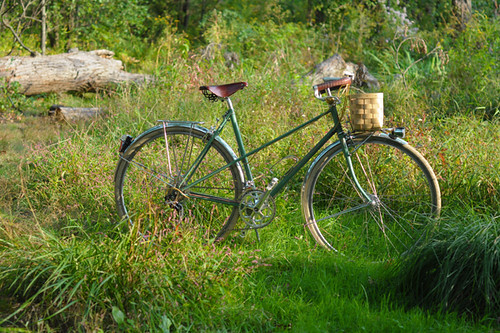

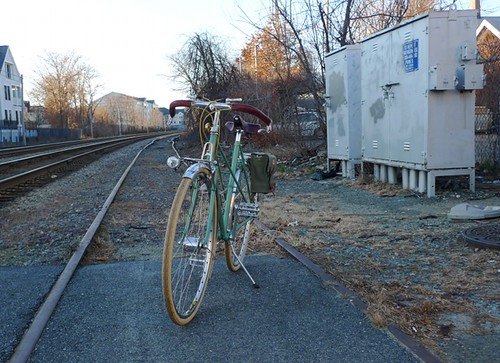


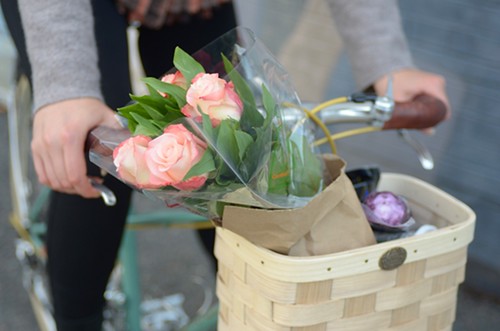
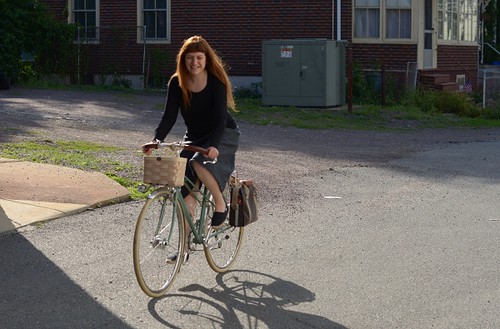
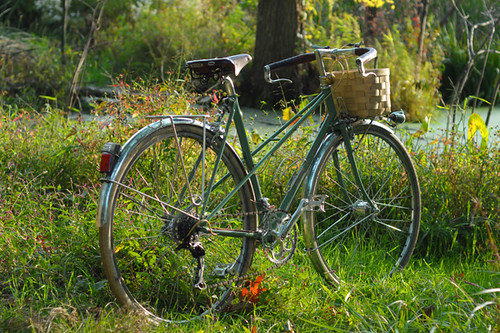
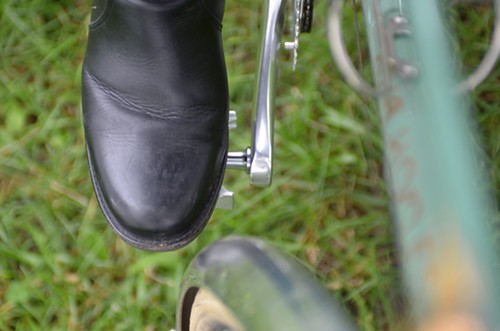
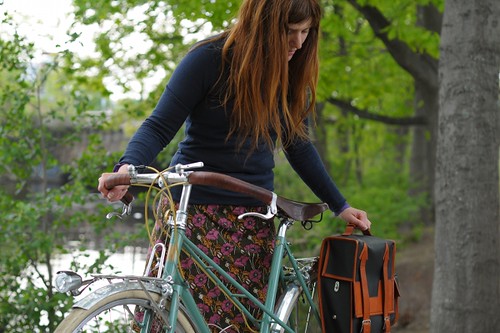


V -
ReplyDeleteI find myself leaving the nice bike at home for some transportation errands because I worry about theft of parts or the entire bike. I love a nice bike, but it can sometimes be a hindrance that prevents riding it as much as I would like to.
You don't write about rides on this bike much. Mostly you seem to use the Riv as your 'go to' bike. Do you prefer the Riv?
On toe strike - I don't find that bothersome, but clearly, you do. What does bother me is pedal strike. This can be avoided by not pedaling through turns, but the bike I ride most of the time doesn't have the issue, so when I get on a less frequently ridden bike and it happens, it really annoys - and it's un-safe. I expect I'd acclimate to it if I rode the pedal strike prone bike more often.
Pedal strike, among other things, is why I sold my Brompton. In many ways, that was a good bike, but it had issues in several critical areas (pedal strike, poor ride quality, slow, 'shoe stag') which caused me to ride it less and ultimately sell it. Brompton has a loyal following, but it didn't work for me.
Could you tell us what kind of tubing Bryan used?
ReplyDeleteAh, toe overlap. I hate it. I've nearly gone down numerous times on my Rivendell Longlow. Try climbing a two lane road with tarffic on a loaded bike at 4 to 5 mph. At that speed it's not easy to move in a nice straight line and that front wheel moves left to right a bit.
ReplyDeletearevee - I was afraid to leave it locked up for the first couple of months. Then as I started to ride it more and more, I got over it.
ReplyDeleteI'm pretty sure I have more posts showing the mixte here than the Rivendell. I definitely do not use the Riv as my go-to bike, since I never ride it for transportation.
Pedal strike is something I dislike also, but this bicycle has a high BB and does not even come close to it. If pedal strike is a problem on the Brompton, that is something seriously worth noting - I did not notice it during my limited test rides.
sausend - I don't know the tubing he used other than that it's a combination of Columbus, Vitus, Nova, and 4130 straight gauge for the stays. Will have to ask about diameter. Keep in mind that it would be pertinent only to frames with mixte construction though.
ReplyDeleteI've always thought the Nitto flat bars made for Jitensha Studio would make a great commuter bar. http://www.jitensha.com/eng/8-07-650ebisu.html
ReplyDeleteI even considered them for my road bike, which may still happen.
re Brompton
ReplyDeleteAnother problem worth noting as that the model I owned had a nasty habit of catching on the tops of walking shoes at the point were the small push wheels attached to the frame. The dealer suggested 'you'll get used to it' and that I try riding with my heals out. The way it snagged shoes that I frequently wore was unacceptable. I've never read about this issue in any reviews. Perhaps it was unique to my situation.
From a strict standpoint if you change one geo number the rest changes for similar handling. I wouldn't get too hung up on the virtual tt alone.
ReplyDeleteArevee - Wait, did you also make these comments in my posts about the Brompton and I overlooked them? If not, please could you do me a favour and post them there as well. I know loads of people read those ride reports and it would be great to have well-balanced feedback from Brompton owners:
ReplyDeleteBrompton: an extended test ride
In the raw
Jim - In this case I think it might be as easy as lengthening the virtual TT, because it is unusually short on this bike compared to any other bike I ride. We measured it, and it looks like 52cm. I normally ride 54cm+.
ReplyDeleteIt does look pretty short, but what I'm saying is say on my custom: originally I wanted so much slope and trusted the builder on the other numbers. He recommended another slope and threw me a numbers sheet which had a 58cm virtual tt. Eventually we compromised; the final drawing spec'd a 57.5cm virtual tt. I found that some other numbers changed, like front-center, and ht angle.
ReplyDeleteI thought, "why would slope have anything to do with the other numbers?" but trusted the builder. Turns out he was right, of course.
The right builder has certain tools he uses and intuition from his experience as a fitter that makes him more qualified than others, imo. It's at least as important as fabricating a flawless frame.
It's hard to say when to trust the builder once you make sure they understand your criteria and when to insist on numbers. In this case I did 100% the former and it did not work out perfectly (no toe overlap was something I asked for from the start). Others have had similar experiences with other builders. On the other hand, many a time the customer specifies numbers and the end result turns out awful - because the customer knows just enough about numbers to feel confident insisting, but not enough to understand the whole picture. Like you said. So either way could work out perfectly or could go wrong. It's a tricky process.
ReplyDeleteTrust - that's when the builder's experience comes in: number of rep's, number of fittings.
ReplyDeletePicking the right builder also means he won't build something that doesn't make sense to him too. Often times a builder will accept an awful design to keep the $ rolling in; can't really fault him for that.
I had a similar change in needs and re-purposing of my Rivendell. It was originally designed as a mixed-surface & dirt-road/fire-trail scrambler. At the time, I lived right next to a conservancy managed open space, and rode there daily. Since then I've moved and live in a more built up area. Most of my rides have a lot more asphalt underneath them, and the Riv is over-built for that. I ended up buying a road bike and not using my All-Rounder so much for those rides.
ReplyDeleteNow, when I do want to get out for some serious dirt, it's not so much out my back door (although I do manage to find it pretty well!). I often now drive up to the local mountains for single track, and the Riv just isn't cut out for that. So I have a 29er in addition to my do-everything bike and the road bike.
Similar to you, this custom that I planned on having as my one and only do everything bike is now being used as a transportation & utility bike. A very expensive transportation & utility bike, but it still gets the most miles over my more specialized bikes.
cyclotourist - You make a good point in your last paragraph. When we first built up the bike, my husband teased me that I now have an expensive, redundant transport bike (as I already had 2 other transport bikes). Now his view is different, because he sees me riding this bike constantly and also being more "in control" of it in traffic than I am of, say my Dutch bike. Also, being able to casually ride an upright bike for 20+ miles at a time in regular clothing in the summer months and be none the worse for wear is, frankly, impressive. So... who's to say that a specialised road/race/off road bike has more value than a versatile commuter? I would argue against that perception.
ReplyDeleteMaybe you could shave the tread? They do it to Hetres, there's a lot more rubber waiting for a haircut on Delta Cruisers. Then you move the fender in. 3mm less toe overlap is 3mm even if this is a goofy suggestion and you have the only shaved DCs on the planet.
ReplyDeleteOr indent the fender at the offending spot. A fender that's supertight at one clearly known point is easier to manage than one that's tight everywhere.
At the risk of committing heresy, there are other tires in the world. It's a good looking bike. It's a great looking bike. Jack Browns would look good on this bike. Not the same, good. Since you ride far and fast now, Delta Cruisers may no longer be the ticket.
"At the risk of committing heresy, there are other tires in the world."
ReplyDeleteHeresy!!!
Not really : ) But I do like them and prefer to keep them. They are nice for going off road, too. Denting the fender is an interesting option - could be a new look!
What an intriguing description of the ride quality! Did you ask for the frame to be flexible? Why do you not think it's "everyone's cup of tea" if you like it?
ReplyDeleteDella - I did not ask for flex specifically, but I asked for the bike to be comfortable - stressing that I didn't want to be in pain from road vibration and harsh ride quality, as I was on the vintage mixte I owned before this bike. The flex pretty much achieves exactly what I asked for.
ReplyDeleteAs for why I don't think it's for everyone... There is a bias against flexible frames that comes from racing and the idea that stiff frames are faster and that flex (like suspension) makes you lose power. Having said that, by no means do I feel that this bike is not fast enough; far from it.
Oh! Coincidentally, you can read all about frame stiffness on Jan Heine's blogpost today.
ReplyDeleteSteel frames do not normally have any noticeable flex under 125# riders. Short tubes in normal wall thicknesses that would survive a bigger rider just don't bend under the light load. It's the lack of a top tube and carrying baggage that's creating flex. That's not a surprise.
ReplyDeleteWhat surprises is that flex from baggage loads is being experienced as comfort rather than whip or tailwagging. Royal H did something very right. You should get whatever info he retains on tube specs while he still retains it. Valuable information for the next build or in guessing the likely ride of any frame whose specs are available.
Back when it was available the Vitus 979, made with small-diameter aluminum tubes, was continuously derided as impossibly flexible. Sean Kelly won races on them year after year. Mostly in sprints. Lots of races. He also won a few on his Sabliere painted to look like a Vitus. Also small diameter aluminum and even flexier. The Sabliere weighed 12 pounds. Thirty years ago.
Anon - It's not the baggage. I experience the same sensation when it's just me alone. Over bumps it is comparable to the feeling of riding with a suspension fork, only to a lesser extent.
ReplyDeleteVelouria @ 11:51
ReplyDeleteThen it's all down to lack of a top tube. Or so it would seem as far as I can understand it. As if the frame is a leaf spring rather than a rigid triangle. One side of the triangle is missing.
Get the specs on those tubes. This is interesting.
The rear triangle is braced and well braced. No matter how light the stays, there's an extra set, closely spaced, totally triangulated. The flex would come from the span between seat tube and head tube. Maybe RH was right to keep it short.
If this thing tracks straight,keeps tracking straight when you give it power or hit a descent, sounds like you've got the perfect bike for a person your weight.
Maybe we just don't all need toptubes.
It definitely tracks straight - including on fast descents; that's one distinct feature I've noticed from the beginning. Will ask Bryan about the tubing specifics, assuming he still remembers!
ReplyDeleteIt may or may not be worth noting that the long stem + short sweep bars I have on there right now, place me significantly forward on the bike despite the upright position. This no doubt contributes to how maneuverable it feels.
I wonder why you put the little bell just above the headset instead of near the left (or right) grip. I think when a cyclist needs to use the little bell to signal his presence it's also important to hold the handlebar firmly with both hands?
ReplyDeleteGiles - The original idea behind the handlebar setup, was to have unimpeded use of the entire bars for multiple hand positions. That is why I chose the inverse levers and placed the shifters in the front. However, I am now rethinking whether that is necessary (as I don't really do 50+ mile rides on this bike as originally intended). If/when I change the setup, I may very well have the bell on the handlebars. Although I can easily ride the bike one-handed in traffic; it's very stable.
ReplyDeleteHowever, I am now rethinking whether that is necessary (as I don't really do 50+ mile rides on this bike as originally intended)
ReplyDeleteI find that I ride the front of the porteur bars a lot lately, as it gives me that extra forward lean that I seem to want more and more of lately. For me, they are the perfect urban alternative to drop bars, allowing me to play with different hand positions-- even if my rides are usually less than 5 miles. I considered trying some other bars out just for fun, but every time I ride with these bars, I appreciate them all over again. I also think the swept back angle is about perfect for my hands. They're definitely keepers.
You said it yourself: You are not a typical customer. You are okay with experimenting and probably got a discount from the frambuilder on account of working together. So what do you recommend for those of us who are hoping for a once in a lifetime bike and are not interested in a learning experience? It sounds like there is no guarantee that we will be understood by the builder, no matter how well we may try to explain what we want.
ReplyDeleteJolene -
ReplyDeleteTo clarify, I did not get a discount from the builder. In September 2009 Bryan was just starting out on his own (after working full time at Seven Cycles) and his prices were considerably lower than they are now, so the frame was indeed affordable. But it would have been the same for me vs anyone else; I was just a regular walk-in customer.
You bring up a good point about framebuilder/customer interaction. All I can say is that there is no guarantee on anything that is custom, and this is not unique to bikes. The only thing I can suggest, is to be as specific as possible, and also to go to a builder who is known to specialise in the kind of bicycle you want. If at all possible, try other bikes they've made to see how you like them.
"I was just a regular walk-in customer."
ReplyDelete...yeah, with a popular blog! ;)
So how would you rate Royal as a framebuilder after working with him on 2 bikes & presumably seeing the work of many others?
Well, my blog was not all that popular in September 2009; it had maybe 1/10th of the readership it has now. But moreover Bryan did not know about it when he gave me a price quote. FWIW last winter I ordered my second custom frame from a well known builder who was well aware of my blog, and they did not treat me any differently than they would have a blogless customer. I waited a while just like anyone else and I paid full price. I am not looking for special treatment unless I collaborate with the builder or it's an overt and fully disclosed sponsorship.
ReplyDeleteRoyal H. as a framebuilder... I am of course now biased, but honestly I think Bryan is as good as it gets, and the only reason I'd go to a different framebuilder is out of sheer curiosity and because I can no longer afford Bryan's frames : ) But I think what differentiates him is that he has a sound knowledge of physics and engineering, which not all framebuilders possess, and his finishing is impeccable. I am considering a Randonneur frame for myself next year, and if I pull the trigger it will be via Royal H for sure.
somervillain - I thought that I would use the front of the Porteurs in the city, but I don't, though I do use them long distance.
ReplyDeleteHowever, it should probably be mentioned that getting a frame vs getting a complete assembled bike are different experiences and if one is unable to assemble the bike, someone experienced with similar tastes should be chosen for the job. Framebuilders sometimes assemble bikes, but that doesn't mean they are great at it. :)
ReplyDeleteI think that if a customer wants the framebuilder to assemble the bike and/or choose components, then just as with building a frame they should be specific. Instead of "wide tires" they should specify the tires they want, instead of "fenders" - state at least what style fenders, same with lighting and so on. A lot of these things are subjective and customers don't realise that until the bike is put together differently than they had envisioned. And yes, component choice aside, bicycle assembly is an entirely different skill than framebuilding.
ReplyDeleteV - I've been following your growing interest in frame geometry and I think the role of bicycle designer suits you. You have a knack for making bicycles look desirable which is what drives the market and I am sure you've noticed all the copy cats on flicr with bicycle builds and repaints fashioned after your mixte. Looking forward to seeing how things develop, though a word of advice is you may want to take steps to protect your unique look
ReplyDeleteRoger - Thanks, but the look I am going for is not exactly original, so I can hardly be indignant if others copy : )
ReplyDeleteSorry for the earlier insinuation, was only teasing ;) And I see in your original review now that you explain about the pricing. Jealous how many frame builders are in your area. "Get'em when their starting out" seems to be the way to go.
ReplyDeleteAnon 11:33 & 1:05:
ReplyDeleteHere's Bryan's feedback about the tubing diameter:
tt- 12.5mm (0.5" straight gauge 4130 tube, 0.028 or 0.035" wall)
dt- 28.6mm (1.125" double butted 0.8/0.4/0.8mm wall tube)
st- 28.6mm (1.125" single butted 0.9/0.6mm wall tube)
ss- 14mm single taper
cs- 22.2mm round-oval-round
aargh, where did you get the Zwei bag you are using for a pannier in the third? and fourth picture? I want a set of those.
ReplyDeleteDo you mean this bag?
ReplyDeleteWhat type/brand are the shifters on this beauty? I'm restoring a Peugeot mixte (Monte-Carlo) for my co-habitant, and thoose shifters would be perfect!
ReplyDeleteHello LovelyBicycle,
ReplyDeleteBeautiful bike and great blog! I recently purchased a mixte portuer and am in utter lover with her geometry. I still have my vintage Focus road bike from Japan, but was looking for something a touch less zippy and a smidgen more upright with a vintage look. Have you ever ridden the Caferacer by Creme Cycles? It's a relatively new handmade line from Poland (although I heard that the tubes are constructed in Vietnam). And apart from the IGH it seems to be very similar to your mixte colab. with RHC. There is very little literature or reviews on-line if you have any words of advice or thoughts I would appreciate it greatly! Thanks!
I loved this article, and appreciate your obsessive attention to detail. I lucked into my Nishiki which was abandoned. I didn't need to do much to make it perfect for daily use. I take it through the hills in the bay area and even on some mountain bike trails with the road tires. This is the perfect all-around bike for me.
ReplyDelete